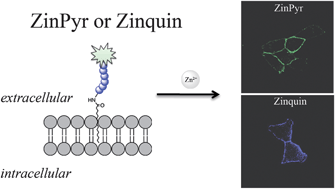Research published in Chemical Science describes the design of a new fluorescent probe that can sense ‘mobile’ zinc outside cells by using a targeting peptide that delivers the probe to the extracellular side of the plasma membrane.
Understanding zinc signalling is a significant area of interest in biological studies. Readily-exchangeable or ‘mobile’ zinc is important in human health and has been shown to have a role in the function of the pancreas, prostate and central nervous system. Current fluorescent zinc sensors tend to be based on small molecules that readily diffuse across cell membranes to give information on zinc in the intracellular environment, but it is difficult to predict how these sensors are distributed beyond the cell membrane where it would be useful to monitor zinc ions released by cells.
Scientists in the United States have developed a design for a zinc sensor that is directed the extracellular plasma membrane by attaching the zinc-signalling fluorophore to a membrane-targeting peptide scaffold. The probes can be readily prepared by solid-phase synthesis to insert the targeting peptide between the fluorophore and a fatty acid that anchors the probe to the cell membrane. The scientists conducted live cell imaging experiments that gave a positive signal for zinc in the plasma membranes of the cells.
Read the ‘HOT’ article for free today:
Peptide-based targeting of fluorescent zinc sensors to the plasma membrane of live cells
Robert J. Radford,a Wen Chyana and Stephen J. Lippard*a
Chem. Sci., 2013, Advance Article, DOI: 10.1039/C3SC50974E











